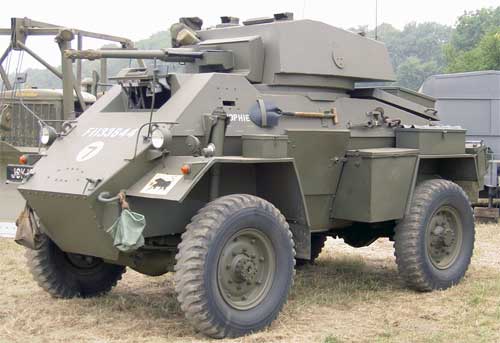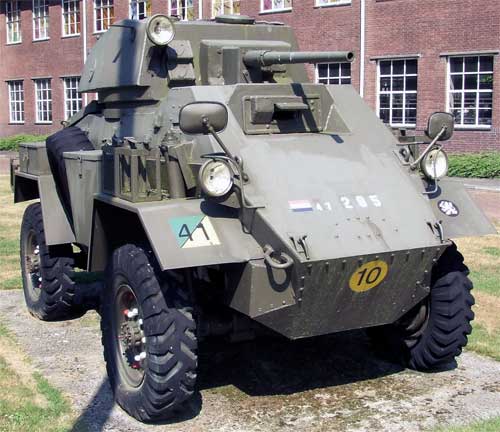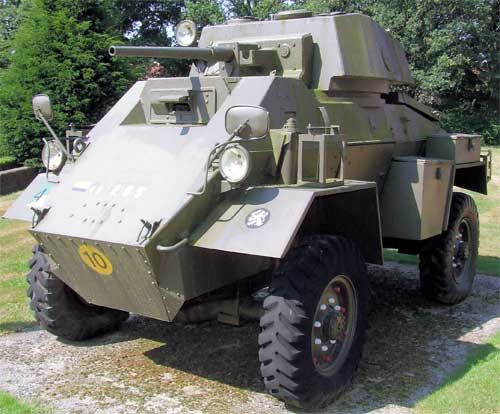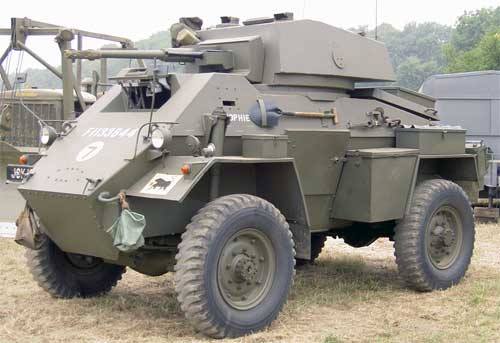
Reconnaissance armored car Humber Mk.IV
Content
Reconnaissance armored car Humber Mk.IVArmoured Car, Humber;
The armored car had a relatively high body, the upper armor plates of which were located at some angle to the vertical. The thickness of the frontal armor of the hull was 16 mm, the side armor was 5 mm, the thickness of the frontal armor of the turret reached 20 mm. In the undercarriage of the armored car, two drive axles with single wheels are used, having tires of an increased section with powerful cargo hooks. Due to this, armored vehicles with a relatively low specific power had good maneuverability and maneuverability. An anti-aircraft self-propelled mount with a quad anti-aircraft machine-gun mount was created on the basis of the Humber.
Given the contractual obligations to the British government for the production of trucks and artillery tractors for the British army, Guy Motors was not able to produce enough armored vehicles to meet the ever-increasing demand for them among the troops. For this reason, she transferred the order for the production of armored vehicles to the Carrier Company, which was part of the industrial corporation Roots Group. During the war years, this company built more than 60% of all British armored vehicles, and many of them were called "Humber". However, Guy Motors continued to produce welded armored hulls, which were mounted on the Humber chassis.
The basis of the armored car "Humber" Mk. I were laid on the hull of the armored car "Guy" Mk. I and the chassis of the artillery tractor "Carrier" KT4, which was supplied to India in the pre-war period. In order for the chassis to fit the “Guy” hull, the engine had to be moved back. In the double tower of circular rotation housed 15-mm and 7,92-mm machine guns "Beza". The combat weight of the vehicle was 6,8t. Externally, the armored cars "Guy" Mk I and "Humber" Mk I were very similar, but the "Humber" could be distinguished by the horizontal rear fenders and elongated front shock absorbers. As a means of communication, armored vehicles were equipped with radio stations No. 19. A total of 300 vehicles of this type were produced.
At the rear of the hull was the engine compartment, which housed a six-cylinder, carbureted, in-line, liquid-cooled Roots engine with a displacement of 4086 cm3, developing a power of 66,2 kW (90 hp) at 3200 rpm. The Roots engine was mated to a transmission that included a dry friction clutch, a four-speed gearbox, a two-speed transfer case, and hydraulic brakes. In the all-wheel drive suspension with semi-elliptical leaf springs, wheels with tires of size 10,50-20 were used.
Generally British armored vehicles During the Second World War, they were technically superior to similar machines produced in other countries, and the Humber was no exception to this rule. Well-armed and well-armored, it had excellent off-road capability when driving over rough terrain, and on paved roads it moved at a maximum speed of 72 km/h. Later modifications of the Humber retained the basic engine and chassis; the main changes were made to the hull, turret and armament. On the Humber Mk IV, the American 37-mm M6 anti-tank gun with 71 rounds of ammunition was installed as the main armament. At the same time, the 7,92-mm Beza machine gun, for which there were 2475 rounds, was also preserved in the tower. Thus, during the Second World War, this armored car became the first English wheeled combat vehicle with cannon armament. However, the placement of a larger gun in the turret forced a return to the previous crew size - three people. The combat weight of the vehicle increased to 7,25 tons. This modification became the most numerous - 2000 Humber Mk IV armored vehicles rolled off the Carrier assembly line.
From 1941 to 1945, 3652 Humbers of all modifications were manufactured. In addition to Great Britain, armored vehicles of this type were produced in Canada under the name “General Motors armored car Mk I (“FOX” I)”. Canadian armored cars were heavier than British and equipped with more powerful engines. The total number of Humbers produced in the UK and Canada amounted to almost 5600 cars; thus, an armored car of this type became the most massive English medium armored car during the Second World War. Armored vehicles "Humber" of various modifications were used in all theaters of military operations of the Second World War. From the end of 1941, vehicles of this type fought in North Africa as part of the 11th Hussars of the 2nd New Zealand Division and other units. A small number of Humbers were involved in patrolling communications in Iran, along which cargo was delivered to the USSR.
In the fighting in Western Europe, mainly the Mk IV modification machines were used. They were in service with the reconnaissance regiments of the infantry divisions. 50 Humber MkI armored cars were in the Indian army in His Majesty King George V's own 19th Lancers. After the Second World War, the Humbers were not long in service with the British army, giving way to new types of armored vehicles . In the armies of other countries (Burma, Ceylon, Cyprus, Mexico, etc.), they were operated much longer. In 1961, several armored vehicles of this type were in the Portuguese troops stationed in Goa, a Portuguese colony in India. Tactical and technical characteristics of the armored car "Humber"
Sources:
|
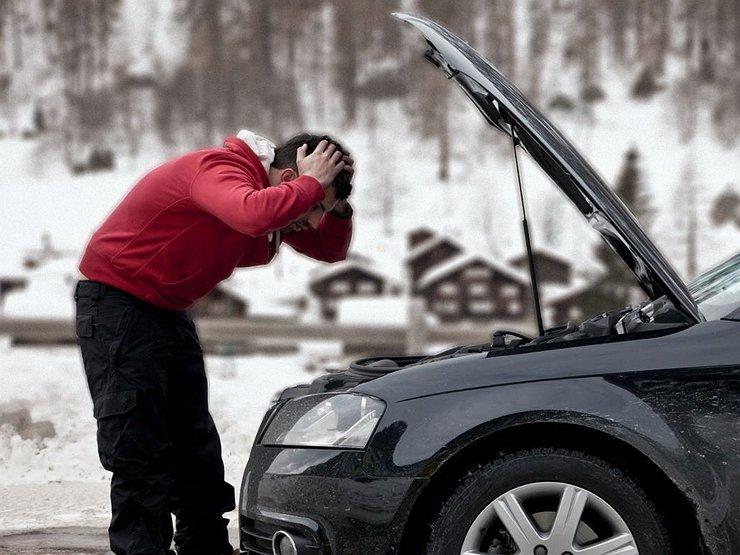
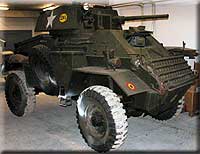 Armored cars "Humber" began to enter the reconnaissance units of the British army in 1942. Although their design used mainly standard automotive units, they had a tank layout: the power compartment with a liquid-cooled carburetor engine was located at the rear, the fighting compartment was in the middle part of the hull, and the control compartment was in the front. The armament was installed in a relatively large turret mounted in the fighting compartment. Modifications of the armored car I-III were armed with a 15-mm machine gun, modification IV was armed with a 37-mm cannon and a 7,92-mm machine gun coaxial with it. Another machine gun was used as an anti-aircraft gun and was mounted on the roof of the tower.
Armored cars "Humber" began to enter the reconnaissance units of the British army in 1942. Although their design used mainly standard automotive units, they had a tank layout: the power compartment with a liquid-cooled carburetor engine was located at the rear, the fighting compartment was in the middle part of the hull, and the control compartment was in the front. The armament was installed in a relatively large turret mounted in the fighting compartment. Modifications of the armored car I-III were armed with a 15-mm machine gun, modification IV was armed with a 37-mm cannon and a 7,92-mm machine gun coaxial with it. Another machine gun was used as an anti-aircraft gun and was mounted on the roof of the tower.